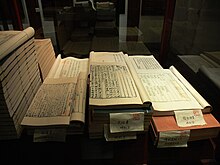Book of Han
| Book of Han | |||||||||||||||||||||||||||||||
 |
|||||||||||||||||||||||||||||||
| Traditional Chinese | 漢書 | ||||||||||||||||||||||||||||||
|---|---|---|---|---|---|---|---|---|---|---|---|---|---|---|---|---|---|---|---|---|---|---|---|---|---|---|---|---|---|---|---|
| Simplified Chinese | 汉书 | ||||||||||||||||||||||||||||||
|
|||||||||||||||||||||||||||||||
| Transcriptions | |
|---|---|
| Standard Mandarin | |
| Hanyu Pinyin | Hàn shū |
| Gwoyeu Romatzyh | Hann shu |
| Wade–Giles | Han4 shu1 |
| IPA | [xân ʂú] |
| Yue: Cantonese | |
| Yale Romanization | Hon-syū |
| Jyutping | Hon3-syu1 |
| Southern Min | |
| Tâi-lô | Hàn-tsu (col.) Hàn-su (lit.) |
| Middle Chinese | |
| Middle Chinese | xàn sho |
| Old Chinese | |
| Baxter-Sagart | *n̥ˤar-s s-ta |
The Book of Han or History of the Former Han is a history of China finished in 111, covering the Western, or Former Han dynasty from the first emperor in 206 BCE to the fall of Wang Mang in 23 CE. It is also called the Book of Former Han.
The work was composed by Ban Gu, a court official, with the help of his sister Ban Zhao, continuing the work of their father, Ban Biao. They modeled their work on the Records of the Grand Historian, a universal history, but theirs was the first in this annals-biography form to cover a single dynasty. It is the best source, sometimes the only one, for many topics in this period. A second work, the Book of the Later Han covers the Eastern Han period from 25 to 220, and was composed in the fifth century by Fan Ye (398–445).
This history developed from a continuation of Sima Qian's Records of the Grand Historian, initiated by Ban Gu's father, Ban Biao, at the beginning of the Later Han Dynasty. This work is usually referred to as Later Traditions (後傳), which clearly indicates that the elder Ban's work was meant to be a continuation. (It should be noted that other scholars of the time, including Liu Xin and Yang Xiong also worked on continuations of Sima's history.) After Ban Biao's death, his eldest son Ban Gu was dissatisfied with what his father had completed, and he began a new history that started with the beginning of the Han dynasty. This distinguished it from Sima Qian's history, which had begun with China's earliest legendary rulers. In this way, Ban Gu initiated the Jizhuanti (纪传体) format for dynastic histories that was to remain the model for the official histories until modern times.
...
Wikipedia
